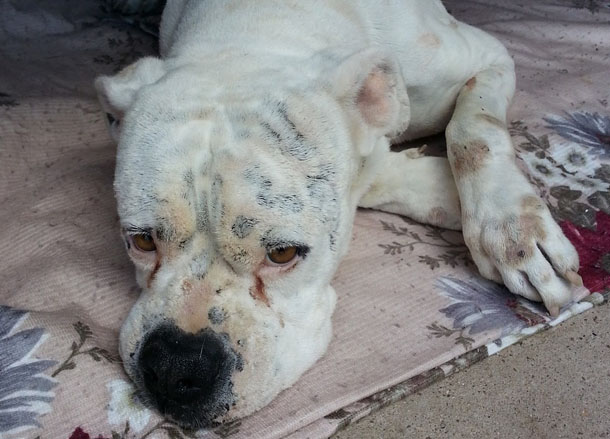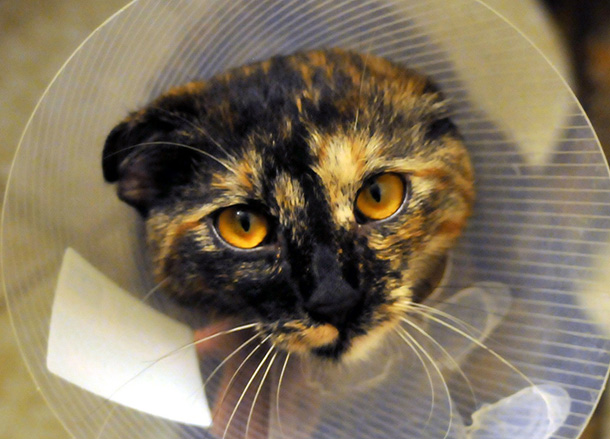Posts in Category: Pet Tips
What You Need to Know about Gum Disease
Happy New Year! We hope you and your family and friends—furry and otherwise—enjoyed a relaxing holiday break!
As we start a new year, it’s time to shed light on the most common disease occurring in adult dogs and cats, and a problem we see in patients every day at Medical District Veterinary Clinic: gum disease.
With National Dental Health Month coming up in February, we want to educate our clients about how to prevent and treat gum disease.
According to the American Veterinary Medical Association, 80 percent of dogs and 70 percent of cats will exhibit some stage of gum disease (also called periodontal disease) by two years of age. The early stage of gum disease, called gingivitis, occurs when harmful bacteria cause the gums to become very red and inflamed. As the disease progresses, plaque forms both on the tooth surface and under the gum line. As bacteria and plaque increase, pets can experience pain, bone loss, and ultimately loose teeth.
How do you spot gum disease in your dog or cat? Unfortunately, this problem typically goes unnoticed and untreated in the earliest stages. Common signs of advanced dental disease include:
- bad breath
- red/inflamed gums
- loose teeth
- missing teeth,
- discolored teeth
Prevention is the key. The best way to prevent bacterial buildup in the mouth and periodontal disease is daily tooth brushing. We realize that may not be a very practical option for most of you, since there is often a lack of time or cooperation. Never use toothpaste marketed for people; choose toothpaste formulated for dogs and cats. Other options include dental rinses and dental chews. A list of products proven to help decrease plaque and tartar buildup can be found at http://www.vohc.org/accepted_products.htm.
For pets with developed periodontal disease, ultrasonic cleaning to remove all the calculus and plaque from the tooth surface and under the gum line is needed. We also recommend taking dental radiographs (X-rays) to check for disease near the roots of the teeth. Some dogs and cats seem predisposed to dental problems and need cleanings yearly, while other pets can go longer between cleanings.
When it comes to dental cleanings, the main difference between people and pets is anesthesia. If dogs and cats would hold still with their mouth open for 30 to 60 minutes, we would not need anesthesia to properly clean their teeth. As you know, this is not the case!
Please contact us with any questions you about your pet’s oral health or to schedule an appointment for a dental exam or cleaning.
Remember: February is Dental Health Month, and all dental procedures are 10 percent off for all clients and 15 percent off for students and staff of the University of Illinois at Chicago.
Drew Sullivan, DVM, Director
Medical District Veterinary Clinic
Your Holiday Pet-Safety Checklist
Thanksgiving has come and gone. The temperatures are now consistently low enough to bother the non-native Chicagoans. Bears fans are looking forward to the next NFL draft. And holiday music is leaking out of every single possible speaker, phone, and computer screen.
That means it’s time for us to be the sobering voice of reason and remind you of the dangers to our pets posed by the holiday season.
As your mind drifts to holiday gift lists, vacations, and the slew of abnormal scheduling that occurs during December, pay attention to these concerns and keep your beloved cats and dogs safe and happy.
In no particular order:
Gift Wrapping
Cats love ribbons. Cats eat ribbons. Cats are not meant to eat ribbons. If you have a cat, just avoid ribbons and if you get a gift with ribbons, throw the ribbons away immediately. If you are giving gifts to someone with cats, avoid ribbons. At the risk of disrupting the ribbon industry, I would be happy if ribbons were banned from holiday traditions.
Christmas Trees
Dogs and cats eat tinsel. Tinsel ingestion can lead to, minimally, stomach upset (diarrhea, vomiting, pain, etc.) and, maximally, foreign body obstruction that requires medical intervention.
Dogs and cats also like to chew on Christmas trees and wreaths. We have had a few cats, recently, come in for allergic reactions to glue or fake snow sprayed on wreaths. There is no great way of preventing your animals from getting to these things unless wreaths are hung in places they can’t get to and the tree is put in rooms that can be closed when you are not there to monitor your pets.
More seriously, you have to be careful that your pets do not chew lights and ornaments. Electrocution is possible, causing serious to fatal effects. Ingestion of glass ornaments can cause severe mouth and gastrointestinal bleeding, etc. And then as if this slew of fears isn’t enough to make you anxious, always remember that animals can knock over trees causing damage to themselves and your house.
On a lesser note, I think that every cat and most dogs are very tempted to defecate and urinate in the Christmas tree. Plan on needing some extra scented candles to mask the holiday urine and feces smell-fest.
If you are the sort to wrap a food gift and place it under the tree, please understand that your animals do not respect the lovely ceremonial waiting until Christmas morning to find out what is there. We’ve seen people put candies in stockings, meat products in boxes, and cakes and treats in bags, all to find everything gone in the morning. The subsequent and joyous Christmas morning ER visit may then be needed.
Hanukkah Candles
This also applies to all candles: Make sure to keep all open flames away from animals that could jump on the table and knock the candle over or be burned. Hanukkah candles are not to be extinguished for any reason, so that may mean making sure you don’t buy candles that last for hours. (Hint: The cheaper they are, the faster they burn.)
Treats
Cookies, cakes, pot roast, candied hams/yams, candy. Your animals want all of this. If you bake a cake and then set it down to go check on the kids, your dog will eat it. Your cat will jump on the counter and lick frosting from a bowl. They are probably working together to distract you.
Also, giving your dog a lick of turkey or ham juice may seem like a wondrous holiday gift, but if everyone at dinner or in the house does the same thing, you will be finding that diarrhea, pain, vomiting, and a trip to the ER may also be needed to take care of gastroenteritis/pancreatitis, etc.
As always, be super careful about chocolate.
The bottom line is this: Dogs and cats are a part of our lives and we want them to participate in our holiday fun. But they do not need to eat special things. Put a bow on their normal food or arrange their wet food in the shape of a Christmas tree. They will be happy.
Plants
Poinsettias, mistletoe, and holly can all cause gastrointestinal upset, especially if a large amount is eaten. More seriously is ingestion of decorative lilies and daffodils by cats. Christmas/peace lilies can kill cats. Daffodils, less so, but can cause severe irritation. Just be watchful of pets ingesting anything not normally in the house.
Pet Anxiety
Leaving the house for the day, bringing your dogs/cats to the in-laws, having the new downstairs neighbor check up on the animals…all these things can cause anxiety and secondary stress. Remember that our animals do not always find it fun to travel, see new environments with new smells, animals, kids, etc., or be alone or with strangers taking care of them.
If you have a sensitive dog or cat, try having the caretaker come over a few times before you go to meet the pet and make the pet more comfortable. If you need go out of town, consider finding an alternative, such as leaving your pet with people they already know and trust. If you are going to be gone for longer than normal, make sure pets have ample food and water. If they already suffer from known problems (like GI sensitivity), consider being proactive and giving them gastroprotectants (with our approval) before they get sick. Also think how a giant tree with flashing lights and noises in their favorite corner of the living room may affect their mood and security.
General Cold Weather Wintering for Our Pets
First, remember that your little 20-pound short-haired dog needs to be dressed for winter when going out. Not all of us have Alaskan Malamutes and Huskies. A quick trip around the block in 0-degree weather can be dangerous and uncomfortable. Get some nice winter clothes at the pet supply store or online now before it becomes horrible outside.
Also be careful about the temperature of your home. Maybe this is your first year with a pet and you are used to turning down the heat to 62 when you leave for work. Your little short-haired kitty may be really uncomfortable with that temperature. All pets are different, so talk it over with us, or assess on your own that they are doing their normal things like playing, eating, drinking, etc.
The salt on the sidewalks can cause serious irritation and harm to animals. I like using Mushers Wax on the dog’s paws when they get irritated. It also helps protect paws from the cold, to a degree. You can get this online or at most pet supply stores.
The cold weather makes a dog’s normal outdoor activities (walking, playing in the yard, socializing with other dogs, etc.) less frequent. Take seasonal depression into account when thinking about how your pets feel without these normal stimuli. Come up with some new indoor rituals to replace his extra walk, like fetching, wrestling, or various games. Try having play dates with other (fully vaccinated) dogs with whom your dog gets along. This doesn’t really apply as much to cats, but you should be doing this with your cats any way.
With winter weather comes the use of anti-freeze in our cars. Just be very careful and remember how toxic this is to all animals and humans. If you spill anti-freeze in the garage, DO NOT let your dog go in the garage. Do not leave it around unopened for it to spill even more. Do not throw out any rags with anti-freeze without securing them in a container that would be hard to eat or lick. Be careful of the feral or stray cats that may also seek sanctuary in your garage and also can die from exposure.
Also, despite the projections for a cold Chicago winter, fleas and ticks are still around. We’ve been treating many dogs this season for these parasites. Ticks can live when it is above freezing. When you decide to go on a holiday hike in the forest preserve during a 40-degree Saturday, pets can have tick exposure. You cannot always see ticks, but they are there.
Lastly, New Year’s in a city is always loud. If the most recent Cubs outbreak of loud celebration can tell us anything, it’s that the animals of Chicago did not like the secondary outbreak of fireworks, pots and pans, screaming, and (in our case) Scottish bagpipes being played for hours outside our window. Dr. Kelly Ballantyne, our veterinary behaviorist here, previously discussed how to help noise-averse dogs. In general, remember that having anti-anxiety medications can be very helpful for this situation. Just being aware can help prevent the situation getting out of hand. Closing windows, using white noise distractors, and being attentive and helping your pets get through the countdown on New Year’s Eve can really help. The most common side effects of severe stress is gastroenteritis (vomiting, diarrhea, lack of appetite), self-trauma (licking, biting), and sometimes aggression toward other animals or owners.
Thanks for reading. I hope your holidays are wonderful and stress-free for you and your pets.
P.S. We like pet holiday cards in case you are the sort to send them out to people.
Brett Grossman, DVM
Medical District Veterinary Clinic
Pet Obesity Concerns
Obesity is a major problem for dogs and cats in the United States—in fact October 12 was National Pet Obesity Awareness Day. According to the Association for Pet Obesity Prevention, over 50% of dogs and cats are either overweight or obese. Obesity is often overlooked as a problem by pet owners, but as a veterinarian, I feel it is very important that owners understand the risk factors associated with obesity in their furry family members. Our society has become accustomed to the overweight look. The new “normal” for dogs and cats is overweight. The ideal weight animal is now often viewed as “skinny.” Additionally, with the ever-growing human-animal bond, we are seeing more obesity, since food is often viewed as a form of love. Dogs love treats, and when they give us those little eyes, how can you resist just one more treat?
If you knew what “just one more treat” could do over the years, it may help you resist. There are many risk factors associated with excessive weight in animals. The list includes many of the same risks factors seen in humans: osteoarthritis, diabetes, high blood pressure, heart and respiratory disease, cranial cruciate ligament injury (knee injuries), kidney disease, and decreased life expectancy due to poor quality of life.
I believe that a major problem contributing to pet obesity is pet food companies feeding guidelines. In most cases, pet owners are not purposefully trying to make their animals overweight. They feed according to the guidelines, then they add in treats and dental chews and the occasional table scrap. Dogs and cats don’t need that many calories. When owners are feeding their entire daily caloric need in food, then supplementing treats, this results in weight gain and, ultimately, obesity.
We recommend dogs be fed on a daily caloric need versus based on the feeding guidelines on a bag. We are more than happy to calculate your pet’s daily caloric need based on his/her ideal body weight. We would also be happy to discuss lower calorie food options that may help your little one get to his/her ideal body weight as soon as possible, thus reducing the risk for the many above-mentioned health risks.
Drew Sullivan, DVM, Director
Medical District Veterinary Clinic
Heartworm: One Bite, One Infection, That’s Enough
Pet owners share some common misperceptions about the importance of monthly heartworm medications. So here’s a public service announcement that could save your pet’s life.
Heartworm infections have been diagnosed in all 50 states of the United States. Dog-to-dog transmission has been documented in 49 (good job, Alaska). Heartworms are presumed to be rampant in wild canids (such as wolves), which act as a holding tank for the infection.
Every single dog that ever goes outside is at risk for receiving a bite from a mosquito and subsequently is at risk for contracting heartworm disease. This includes tiny little Chihuahuas that never leave their owner’s arms and dogs that just go to the dog park once in a while. One bite, one infection, that’s enough.
Mosquitoes do not generally do their mosquito thing when temperatures reach below 50 degrees F. That being said, with erratic and warming temperatures, we are seeing temperatures often climbing above this threshold even in the late fall months and early spring.
Some clients suggest that they stop medicating their pet in September and begin again in March or April. This is a not an effective strategy. There are often warmer temperatures late in the year, and the mosquitoes do not care what month it is.
Heartworm protection is easy to give and relatively cheap. There are many different brands from which to choose and different rebates offered for bulk buying. If one buys a year’s worth, it generally comes out to about $10 a month. The cost of treating heartworms is substantial (especially with bigger dogs). It would surpass the cost of heartworm preventative for your dog’s whole life. Treatment for heartworm also is long, can be painful, and in some cases can be fatal.
Though some breeds, including collies, are known to have reactions to heartworm medication, the medication is generally safe and without complications for most dogs.
There are some homeopathic, more natural insecticides that can help fend off mosquitoes, but there is not one specifically designed to prevent heartworms. Your dog is at risk without heartworm medication.
So what should you do?
The safest thing to do is to make sure that your dog is on heartworm preventative all year long. If you live in a state, such as California, that doesn’t see heartworm disease very often, but you travel with your dog to environments with the disease, your dog is at risk and should be tested. In fact, every dog should be tested once a year to confirm that heartworm disease is not present.
Also, just a quick note that heartworm can be transmitted to cats (though this is rare) and humans (though this is even rarer). Mostly canids, wild and domestic, are at risk.
If your dog is not current on a heartworm test, or if you need heartworm preventative, or if you have any questions or concerns, let us know.
Brett Grossman, DVM
Medical District Veterinary Clinic
August 2016 Update on Canine Influenza
In recent weeks, there has been an increased surge of coughing dogs coming into our clinic. We had been free of suspected flu cases for a number of months, here, at Medical District Veterinary Clinic, but three weeks ago, we had one confirmed case followed immediately by multiple other subsequent cases that were highly suspicious of the canine flu.
All of these dogs have had a common history of frequenting day care, boarding facilities, or dog parks. We are still continuing to recommend using caution in these areas to help protect your dog. Additionally, we would like to remind our clients that there is an available vaccine against the H3N2 strain of Canine influenza. It requires two initial doses (two to four weeks apart) and then boostered on a yearly basis.
Most cases have started with either mild coughing or sneezing, which eventually has progressed to a loud, honking cough. Some pets have a decreased appetite, depression, and fever. If your pet is showing any of these signs please have your pet examined as soon as possible—time is of the essence to prevent these cases from progressing to life-threatening pneumonia.
Dogs at the highest risk of exposure include those that socialize with other dogs by attending day care, boarding or grooming, dog parks, and those that live in high density enclosed areas such as high rise buildings. Dogs with high risk of exposure should be vaccinated.
We also recommend owners decrease the risks of exposure by trying to avoid these high-risk areas as much as possible. Canine Influenza Virus can survive 48 hours on hard surfaces and 24 hours on clothing, thus it is very important to also be cautious in elevators, hallways, and places where dogs congregate, like dog relief stations or community dog bowls.
Please call the Medical District Veterinary Clinic at (312) 226-2588 with any questions and to schedule a vaccine appointment.
Thank you,
Drew Sullivan, DVM
Medical District Veterinary Clinic
Canine Influenza Virus Update
It’s been a year since Chicago got caught up in and defeated by the Canine Influenza Virus Apocalypse of 2015. While the collective veterinary world knocks on wood, we can say that there has not been the return we were dreading. However, we are not free from all concerns, so here is a flu review and information on current recommendations.
Before last year, the canine influenza virus (CIV) vaccine protected dogs from the H3N8 strain, which was the only strain circulating in the United States. The cause of the Chicago outbreak of 2015 was identified as a new strain, H3N2, previously seen only in southern China and South Korean dog populations.
Typically CIV cases are not typed by a diagnostic laboratory, but with last year’s outbreak most of the cases that were sent in were identified as the H3N2 strain. Now we don’t have any way to know if the older strain, H3N8, is truly gone or merely overshadowed by the more vibrant and headline-grabbing H3N2.
The most obvious and most-often asked question is: How should you protect your dogs?
If your dogs have previously been vaccinated against H3N8, should they continue to be boostered? Should we add H3N2 to their vaccination protocol in addition to or in place of H3N8? Or if the outbreak is over and not really having much effect on the city, is either vaccination needed?
The absolute safest thing to do if you want to confer the most protection against CIV is to vaccinate your dogs against both strains. The first time dogs are vaccinated against one of the strains, they need a one-time booster after two to three weeks, and then subsequent yearly boosters after that to continue to have protection. That being said, the most recent outbreak seemed to be attributable to the H3N2 strain. Though we can never say that the H3N8 strain is gone, we can say with some certainty that it is much less prevalent. Therefore, your dog is much less at risk for this virus. Many owners are choosing, reasonably, to vaccinate their pets only against the new H3N2 strain.
Other factors that must be considered include your dog’s relative risk of contracting CIV and potential negative side effects of the vaccine. The vaccine is safe, but, as with all vaccines, they should not be administered to animals that are currently sick or immunocompromised in any way. The CIV vaccine is an optional vaccine (sometimes called a “lifestyle vaccine”). If your dog is social and goes to dog parks, the groomer, or doggy daycare, or if your dog has contact with other socially active dogs because you live in an apartment complex with a swinging doggy social scene, these are reasons to choose the vaccination(s).
There are still lots of things we don’t know. Did the anticipated outbreak of 2016 fail to happen because of increased awareness? Herd vaccinations of the Chicago dog population? Unknown natural reasons? Will the virus mutate, as it often does in human flu strains? Will the new H3N2 vaccine be effective, and for how long?
Having your dogs vaccinated doesn’t guarantee that they will be free from sickness, but we can guarantee to help you weigh your dog’s options and needs and support the decision you make.
For more background information about CIV, please refer to the American Veterinary Medical Association FAQ. And please do not hesitate to call us with questions about this or other issues.
Thank you,
Brett Grossman, DVM
Drew Sullivan, DVM
Medical District Veterinary Clinic
Your Pet’s Diet
The temperature is slowly creeping up to Chicago springtime levels, though all Midwesterners knew to brace for that inevitable April snowstorm.
Regardless of your gritty Chicago expectations, we hope you are starting or continuing all your flea and tick medications as well as your heartworm control. You can reference the previous post about this, but remember these are two separate medications that need monthly administration. If you have questions, call or bring in your animal. Also with the season changes come allergens. If your dog or cat is susceptible to allergies, watch carefully, and make sure they are not getting uncomfortable.
This month’s topic—your pet’s diet—is one of utmost importance and one that is too often influenced by non-doctors. Your dog’s and cat’s diet is a huge part of their continual care and health, so it is important to know your options.
This column can’t address every aspect of diet, but it can help you figure out if the diet you are using is right for your pets, specifically.
1. Don’t Go by Price
The cost of a diet does not indicate how effective or healthy it is. There are great diets available from your local grocery store. There are not-so-great diets available from your specialty organic pet store. You cannot let cost be what determines what you feed your pet.
2. Special Diets
The sex, age, and specific metabolic status of your animal are integral factors for determining what it should be eating. If you have three cats and two dogs in your house, there’s a chance that they may all benefit from different types of food. That being said, it is not always possible to feed every animal something different, so you need to make sure that you’re not feeding anything that has negative impacts. Puppy food would not be great for an older dog with kidney disease, and geriatric food for an elderly husky that needs to lose weight would not be healthy for a spry little one-year-old mutt. The same goes for cats.
Special diets have been formulated to address specific health conditions in dogs and cats, including:
- Urinary disease
- Stress
- Skin Allergies
- Kidney disease
- Liver disease
- Heart disease
- General aging
- Weight gain
- Joint inflammation and disease
- Recovery from illness
- Diabetes
- Hyperthyroidism
- Puppies (small) / Puppies (large)
- Hairball control
- Indoor / Neutered
3. Grain-Free Diet / Raw Food Diet
Because people’s passions about these types of diets can be fierce, veterinarians are sometimes hesitant to speak out about them. All owners, though, should know that both of these options may have benefits, directly or indirectly, but they are not all healthy and optimal for ALL patients. Please consult with us before switching to any diet, especially for the sick, for the immunocompromised, and for all puppies or kittens.
Grain-Free: It is rare that animals have grain allergies. It is possible, but rare. The perceived health benefits of a grain free-diet are thought to be tied to the amount of generally lower carbohydrates present. Sometimes the grain filler is replaced with other fillers (some with higher amounts of sugar). There’s never really been any conclusive proof that it helps, though nothing suggests that it hinders anything.
Raw Foods: This is a little more controversial, because raw foods can be dangerous, both to animals and to the humans around them. This is the Centers for Disease Control and Prevention (CDC) bulletin on raw food diets. Please consult with a veterinarian AND your family physician before switching to a raw food diet.
Sometimes, we find that staying put on a diet that works is best. There are times when we hear that someone is happy with how their dog or cat is doing, but is made to feel guilty about their pets’ diet because it isn’t proper. Again, let us help, but we don’t like switching foods without a reason.
Enjoy the season change, and let us know if you have any questions.
Brett Grossman, DVM
Drew Sullivan, DVM
Medical District Veterinary Clinic at Illinois
Spring Forward
Spring is weeks away, and the schizophrenic Chicago weather is starting to settle on the easy months of warmth and sunshine, with occasional rainstorms thrown in for good measure. With the winter relief, though, comes additional burdens on pet owners in the form of allergies.
Often pet owners settle for what they view as unavoidable allergic reactions in the form of skin and ear irritation, respiratory difficulty, lethargy, weakness, gastrointestinal upset, etc. As dogs and cats start to lick, chew, and relieve their itching, we start to see them develop rashes, alopecia, anal sac irritation, and infections. Though April showers decrease the airborne pollen, they also will increase the subsequent pollen produced by plants as well as allow favorable environments for mold and fleas.
Sometimes these initial allergic breakouts can be avoided in anticipation of the season, or at first arrival of clinical signs. Often just simply starting antihistamines and a short course of antibiotics or anti-inflammatories can make a severely uncomfortable animal feel like a spring bunny.
So what can you do? We recommended the following:
- Make sure your dogs are on anti-flea and tick prevention. If your cats go outside or if you have dog housemates that go outside, they should also be on flea medication. Flea allergy dermatitis is a common cause for initiating allergic reactions, and ticks can not only initiate allergic reactions, but also tick-borne illnesses like Lyme disease.
- Act quickly and let us see your cats and dogs before it gets bad. Quick responses make simpler and cheaper treatments. Often a quick exam can lead to immediate relief.
- Spring cleaning: Open the windows (keep the screens on) and air out the house, but keep the animals away when you dust and clean. An allergen storm erupting from your winter dust mite carpet cleaning is enough to cause an allergic landslide.
- Wash off the winter grime from your dog’s coat with an appropriate canine-specific shampoo. There are many types of shampoos to use and we can help you figure out what works best.
- Food allergies are common, but if your pet’s signs tend to come at specific times, like at the season’s change, or whenever it rains, it probably isn’t due to food. Before you spend money on new and sometimes expensive food, please let us know. There may be cheaper and easier ways to deal with this. There are many dogs and cats with actual food allergies, but it’s not always the first rule-out.
- I’m sure your dog loves to swim, even when Lake Michigan is still borderline torturously freezing, but post-lake-swimming ear infections are almost too predictable to not mention. Make sure you dry their ears out and potentially clean them after a nice day at the lake. We can show you how before they get infected.
As always, let us know if you have questions. Dental Month has been extended through March, so if you missed out, it’s not too late to take advantage of our discounted dentals.
Brett Grossman, DVM
Medical District Veterinary Clinic at Illinois
Teeth and Beyond
February is quite a month for potential celebration. Even if you limit yourself to going all out only for all those obligatory National Dog Training Month and National Spay/Neuter Awareness Month parties, then you will probably end up stretching yourself thin for the Barley Month, National Pancake Week, National Pizza Day, and Texas Cowboy Poetry Week hoopla. It can get quite exhausting.
But before you cash it in for the month, remember that it’s also National Pet Dental Health Month, and we are celebrating at the Medical District Veterinary Clinic at Illinois by giving you 10% off of all dental procedures (15% for UIC students and employees). Due to client demand, we are extending the discount throughout March. Call us today at (312) 226-2588 to reserve your appointment!
This is both a great time to take advantage of randomly assigned national holidays and also to review the benefits of good dental health.
- One cannot put a price on eliminating your otherwise beautiful and perfect pet’s malodorous breath. Think of all the family gatherings made even more special by not having to try to find the source of the rotting fish smell.
- There can be a great deal of pain and irritation associated with inflamed gums, gingivitis, or teeth infections. Relieving your pets of these problems may help them enjoy eating again, and enjoy their life in general.
- Addressing tooth and gum infections stops the infection from spreading deep into the mouth and even to other internal organs like the heart, kidneys, and liver. Early detection and treatment not only saves your pet from more severe and damaging disease, but also will save you the expense of treating these more serious health problems that could arise if dental health is ignored.
- After a good cleaning is a good time to introduce regular brushing and dental care to prevent plaque buildup. It is generally more difficult–to borderline-impossible–to start a brushing routine when there is substantial plaque and tartar buildup.
- Though there is always risk with anesthesia, complications are rare with healthy dogs. Perhaps it is time to have your animals’ teeth cleaned while they are still happy and healthy, rather than waiting for a variable to complicate their anesthesia risks.
We are happy to discuss the specifics of your pets’ needs at any time as well as give you a very specific cost estimate for what is needed. Just let us know. Don’t let all the Groundhog Day and National Pistachio Day enthusiasts steal the February thunder. Discuss dental health instead.
Thanks,
Brett Grossman, DVM
Drew Sullivan, DVM
Medical District Veterinary Clinic at Illinois
Neuter and Spay, That’s the Way
You probably either know (or are sick of hearing) why you should have your pets spayed and neutered. February is Medical District Veterinary Clinic’s annual Spay and Neuter Month (as well as Dental Month) with significant discounts offered next month to make this process easier for you. Despite that amazingly enthralling introduction, I think it’s time you hear it all again.
Here’s the abbreviated list of what you should know:
- Neutered/Spayed animals will live significantly longer than intact animals.
- Neutered/Spayed animals will have significantly fewer health problems during their lifetime. We see things like cancer (mammary gland, testicular, ovarian, uterine, etc.), infections, and inflammatory issues more frequently in intact animals.
- Intact animals (non-spayed or neutered) can have real live babies. I know this is shocking to some, but if you have two intact animals who can, they will become romantically coupled and have a herd of kittens or puppies, even if you don’t think they will, even if they are related, or even if you swear you are going to keep them apart. Pregnant dogs and cats need extra care and potentially surgical intervention, which can be expensive and dangerous. Kittens and puppies take a lot of time to care for and the shelters of Chicago are already inundated with kittens and puppies from dogs and cats in similar situations.
- Intact animals try to get out of the house and escape the yard for roaming the neighborhood. They will also participate in mounting and marking behavior.
Here’s what we often hear as reasons why people don’t have their animals spayed or neutered:
- Perhaps you signed a restrictive contract with your breeder that you wouldn’t have it done or wouldn’t have it done until later. You may want to investigate whether this is legal. Also think about from whom you would ask questions about your own health—your doctor, or someone who is not your doctor?
- Fido/Trixie is already six years old, so there’s no real reason to do it at this point. This just is not true. Neutering/Spaying is still beneficial because of the aforementioned reasons.
- We often hear that owners would like to have their animals experience the lovely and natural act of love and having a baby. I would firstly advise all of you who are males to ask a female who has had a baby how wonderful the experience was, and secondly, have you ever seen cats and dogs in heat that are not in a scripted romantic comedy? It is not pretty. It involves discomfort, pain, anxiety, and often lots of unwanted fluid secretion. I would also ask you think about how animals view their experiences and how similar it is to our experiences as human. We all know that animals feel a great deal, but how they feel things like “love” and “family” is much different. We have domesticated our animals and they are not in the wild. Reproduction is not necessary and though I cannot tell you, exactly, it may not even be enjoyable. Please google pictures of a cat penis if you want to imagine the joys of feline reproduction. Also there is much data and research on the health benefits of dogs that are spayed before their first heat cycles in comparison to those that have even one.
- We also often hear that an owner was told that anesthesia is dangerous and animals can die while under it. At last look, the international statistics regarding anesthesia in pet dogs and cats is 99.85% success. And this also includes emergency anesthesia, anesthesia on known sick or critical patients, and non-monitored anesthesia without the aid of doctors or certified veterinary technicians. We take great care in watching out for our patients with pre-anesthetic blood work and continual monitoring of all monitors. There is ALWAYS a risk with anesthesia, as there is with human medicine, as well. But there is greater likelihood of secondary diseases from keeping your animals intact than from anesthesia. We, of course, can talk to you at length about your specific animal and decide what is best.
Every patient is different and requires medical decisions that are best for them, and that doesn’t ALWAYS include spaying/neutering. We just want to make sure that you are making those decisions for the correct reasons. If you have questions, let us know. If you don’t have questions, you can also let us know. We would love to hear from you.
February is also dental month, so next month we will have a dental manifesto for your entertainment.
Thank you,
Brett Grossman, DVM
Medical District Veterinary Clinic at Illinois


















